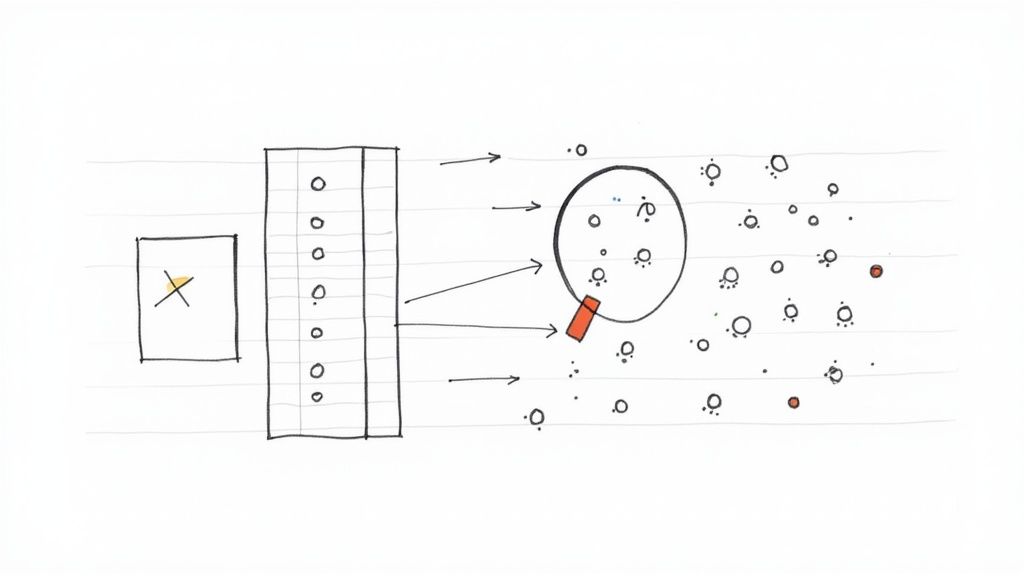
Mastering Lead Generation for Real Estate: Proven Strategies for Agents
Master lead generation for real estate with proven strategies. Learn digital tactics, advanced methods, and optimization for agents & brokers.

If you want to find your target audience, you have to start by getting crystal clear on the specific problem your product solves and who you solve it for. This isn't about guesswork; it's about digging into real data to understand your ideal customer's demographics, their biggest challenges, and what truly motivates them.
Doing this turns a shot-in-the-dark approach into a clear, evidence-based strategy that sharpens every marketing decision you make.
Trying to guess who your customers are is like driving blind. You're moving, sure, but you have no idea where you're going. This kind of guesswork is a surefire way to waste your marketing budget, create messages that fall flat, and build product features no one actually wants. It’s the single biggest reason so many marketing campaigns fail to deliver any real return.
Before you even think about data, let's start with the heart of your product: its core value. You need to stop thinking about features and start talking about the real-world benefits they provide.
Answering these questions gives you a solid foundation. You'll be starting your research with a clear purpose, not just a gut feeling, and you'll have a much better idea of who genuinely needs what you're selling.

Once you have some traffic, you can start gathering actual user data. Tools like Google Analytics show you exactly where your visitors are coming from. This is one of the first and most valuable clues you'll get, revealing where your potential customers are already spending their time online.
Forget expensive market research reports for a moment. Your most powerful clues for finding your ideal audience are already sitting in your sales data. The people who are already buying from you are your best starting point. Let’s dig in and turn that raw data into a real-world picture of who you should be talking to.

You don't need fancy tools to get started. Just open up your CRM, your e-commerce dashboard, or even a simple sales spreadsheet. What we're looking for are the common threads that connect your very best customers.
It's tempting to look at every single person who has ever bought from you, but that’s a mistake. It dilutes the data. Instead, zoom in on the customers who bring the most value to your business—the repeat buyers, the big spenders, or the ones who consistently leave glowing reviews. These people are the blueprint for who you want to attract next.
I’ve found that the classic 80/20 rule almost always applies here. Your top 20% of customers are likely generating 80% of your revenue. By focusing on this core group, you get a much clearer, more concentrated look at what’s truly working.
To build out this profile, start asking specific questions about this top-tier group:
Answering these questions tells you so much more than just who your customers are; it starts to reveal why they chose you in the first place. This is also where you can get a solid handle on your customer lifetime value, which is absolutely essential for building a profitable, long-term marketing plan.
Your current customer base is a fantastic starting point, but it's not the whole story. If you really want to nail down your target audience, you have to look beyond your own data and see what’s happening in the wider market.
Think about it: your competitors are already having conversations with the very people you want to reach. Their marketing is a living, breathing focus group you can observe for free.
Start by taking a close look at who your main rivals are attracting. Who follows them on social media? What kind of language do they use in their ads and on their product pages? Pay attention to the content that gets the most engagement—the comments and shares tell you exactly what’s resonating with people.
This isn't just about copying them. It's about finding the gaps. Are there customer complaints they consistently overlook? Are there questions they never seem to answer? That's where you can swoop in and offer a better solution.
Once you've sized up the competition, it's time to go where your potential customers hang out. Online forums and communities are pure gold for this kind of research.
Places like Reddit, Quora, and niche Facebook Groups are where people talk openly about their problems, using their own words. Search for keywords related to your industry and just listen. You’ll find unfiltered, honest conversations about their frustrations and what they wish they could find on the market.
This isn't just about collecting data; it's about building empathy. When you read these discussions, you start to understand the emotions behind a buying decision. That's way more powerful than just knowing someone's age and location.
This kind of digging gives you the "why" that quantitative data often misses. Your website analytics might tell you what people do, but these communities tell you why they do it. For a more advanced approach, you can even use AI scraper tools to generate sales leads by pinpointing these individuals across different platforms.
Now, let's bring it back to the numbers. Combining what you've learned from communities with hard data gives you a complete picture.
Behavioral data shows you exactly how people interact with websites, ads, and social media content. Tools like Google Analytics are essential here. They track which pages people visit most, how long they stay, and what actions they take. This helps you spot patterns in their behavior, revealing their true interests and buying intent. This information is crucial for building out detailed buyer personas and creating more relevant marketing campaigns.
Okay, you've waded through analytics, sized up the competition, and listened to what people are saying. That's a ton of great data, but data alone can feel a bit... lifeless. It's time to put a human face on all that research. This is where customer personas come in.
Think of personas as character sketches for your ideal customers. They turn abstract numbers and feedback into relatable stories, giving your entire team a clear picture of exactly who you're trying to connect with. We're not just creating a generic profile; we're building a character with real goals, challenges, and motivations.

So, how do you actually breathe life into these personas? You start by weaving all your research into a compelling narrative. Give them a name, an age, maybe a job title. Then, really imagine what a day in their life looks like.
What keeps them up at night? What are they hoping to achieve? This blend of hard demographic data with these softer, psychographic details is what makes a persona a powerful tool for everyone on your team.
Demographics are a huge piece of the puzzle. With global social media usage expected to climb past 5.41 billion users by 2025, the pool of data is massive. Knowing that 95% of U.S. adults aged 18-29 are on YouTube, for example, tells you exactly where you can find certain personas online.
A strong persona isn’t just a file you create and forget. It's a gut check for every single decision. Before you write that ad or design that feature, you should be asking, "Would 'Marketing Manager Molly' actually care about this?"
To make your personas genuinely useful, make sure they include:
For a great resource on taking this to the next level, check out this guide on how to create impactful buyer personas.
Alright, you've built out some sharp-looking personas based on your research. They feel right, but here's the thing: they're still just educated guesses. Now it's time to get out of the office and see if they hold up in the wild. This is where you stop assuming and start confirming.

The great news? You don't need a massive budget for this. You can start small, running practical experiments to get real feedback from the people you think you're targeting.
The goal isn't to be right from the start; it's to get less wrong over time. Every test, whether it succeeds or fails, provides valuable data that refines your understanding and sharpens your strategy.
One of the easiest places to start is with a small, targeted social media ad campaign. Seriously, you can run these for just a few bucks a day.
Craft a simple ad that speaks directly to a pain point you identified for one of your personas. Then, zero in on the exact demographics and interests you've mapped out. This is where you can get really specific with psychographic details—the attitudes, values, and lifestyles of your audience.
In the U.S., a whopping 76% of people have bought something after seeing it in a social media ad. It just goes to show how powerful this can be when you really connect with what drives someone to buy.
Another dead-simple tactic is a quick customer survey. Just a handful of pointed questions can confirm whether you've nailed their biggest goals and challenges. The responses you get back are pure gold for tweaking your personas.
Each of these tests gives you hard data, telling you whether you're warm or cold. Look at the results, make adjustments, and go again. It’s a constant feedback loop. For a more structured way to compare your messaging, our guide on what is A/B testing in marketing breaks down how to run these kinds of experiments. This keeps your understanding of your audience fresh and accurate.
Even with a solid framework, a few questions always seem to pop up when businesses start digging into their target audience. Let's tackle some of the most common ones I hear, because getting these details right can completely change how you use your research.
People often use these terms interchangeably, but they're not the same. It's a classic "all squares are rectangles, but not all rectangles are squares" situation.
Think of your target market as the big, broad group of everyone who could potentially buy from you. It's your entire universe of potential customers. A target audience, on the other hand, is a specific, well-defined segment within that market that you're aiming a particular marketing campaign or message at.
Let’s say you sell home gym equipment. Your target market might be massive: "health-conscious adults in North America." But for your next ad campaign, your target audience could be much tighter: "busy parents, ages 30-45, who need quick, effective workouts they can do from home." See the difference? The audience is focused and actionable.
This is a great question, and the short answer is: more often than you think. Your customer personas are not a "set it and forget it" project. They need to be living documents that grow and change right alongside your business.
As a rule of thumb, I tell clients to schedule a formal persona review at least once a year. You should also pull them out anytime you see a major shift in your data—maybe customer behavior changes, a new competitor arrives, or you launch a new product line.
Markets evolve, and so do people. Regularly checking in ensures you're not marketing to a customer who doesn't exist anymore.
First off, that's a good problem to have! It's actually quite common to find your product resonates with several distinct groups. The biggest mistake you can make is trying to smush them all together into one generic, Franken-persona.
Don't do it.
Instead, create separate, detailed personas for each primary audience segment you've identified. If you run an online graphic design tool, for instance, you might have one persona for "Freelance Social Media Managers" and a completely different one for "Small Business Owners."
They have different needs, different pain points, and different goals. By treating them as unique groups, you can craft messaging, content, and ads that speak directly to what they care about. A one-size-fits-all message usually ends up fitting no one well.
Ready to stop guessing and start connecting with your ideal customers? BrandBooster.ai uses AI and proprietary data to build marketing strategies that deliver real results. We guarantee you'll see a return on your ad spend in 60 days, or you don't pay. Learn more and book your free audit today.